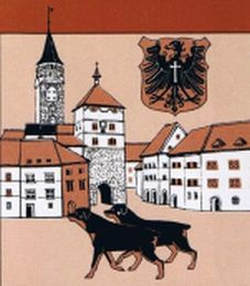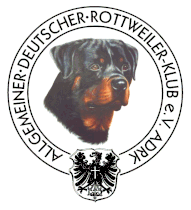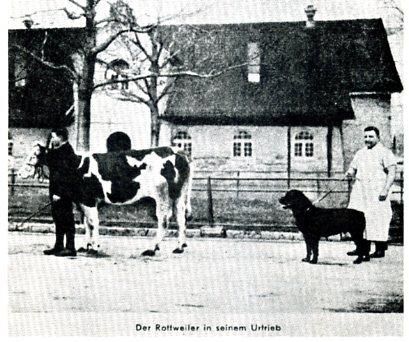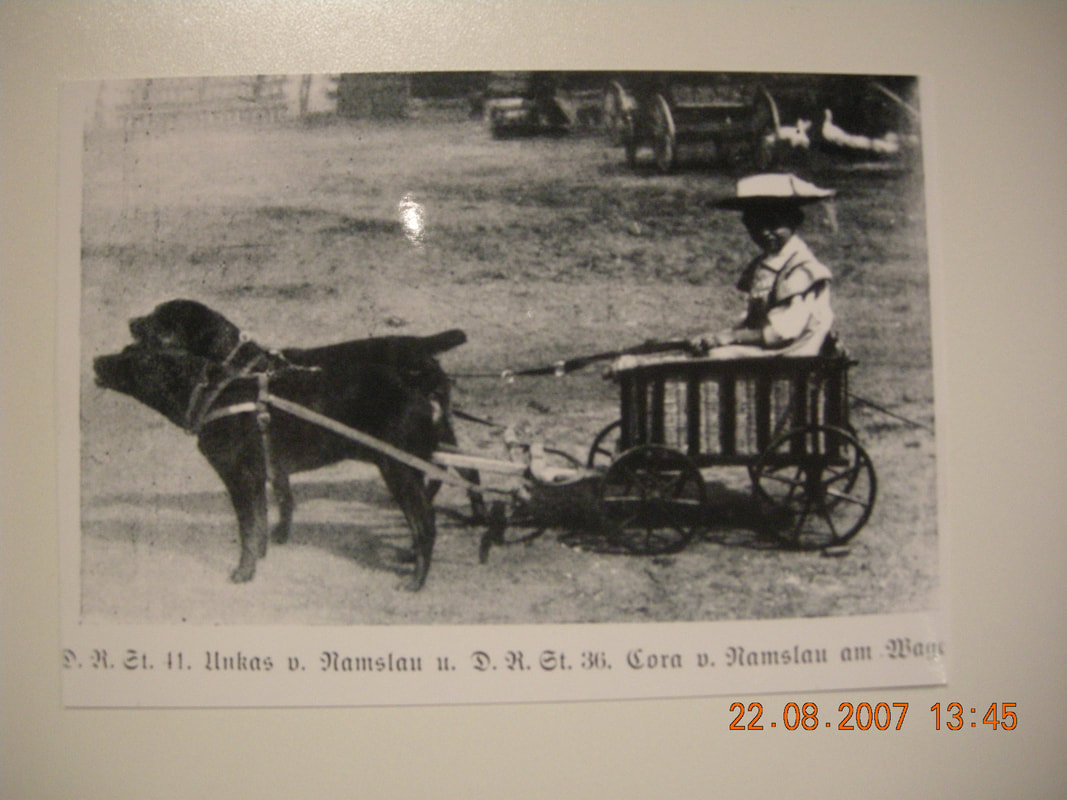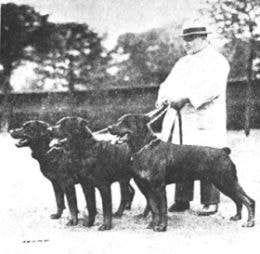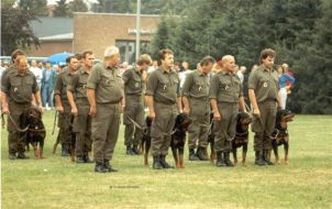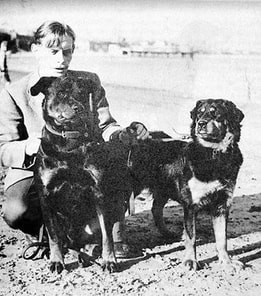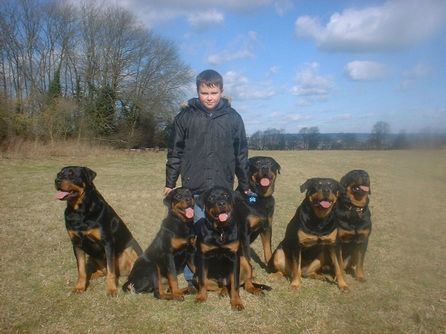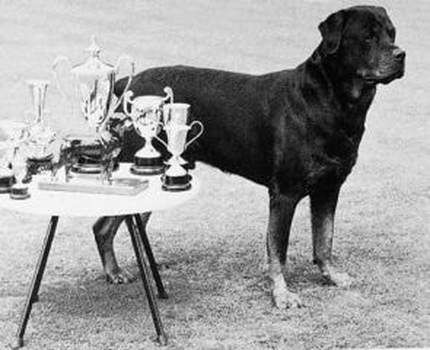The Rottweiler Breed
The breed we share is only given to us in trust. Every decision we make must be made with the objective of preserving it for generations to come. Ultimately this is how we will be judged. For if, in the end the breed no more looks, works or thinks like a Rottweiler – what have we gained?
From the early struggles of their foundation through their dramatic rise in popularity, the Rottweiler has had a punishing journey. Along the way they have given us knowledge and education, unquestioning loyalty and devotion.
It is essential that we ensure the breed can continue its journey in safe hands.
From the early struggles of their foundation through their dramatic rise in popularity, the Rottweiler has had a punishing journey. Along the way they have given us knowledge and education, unquestioning loyalty and devotion.
It is essential that we ensure the breed can continue its journey in safe hands.
Is the Rottweiler Right for You?
“The dark guardian of the family” was used, many years ago, to describe the Rottweiler and this is just as applicable today. It is imperative that you understand the long-term responsibility you will undertake if you decide that the Rottweiler is right for you (and the breeder decides that you are right for it). It is very easy to be captivated by an engaging litter of black and tan bundles of fun, but puppies, like children, grow up all too quickly.
When mature, the Rottweiler is a strong, very demanding, somewhat arrogant animal, with a highly developed guarding instinct. It is essential to understand that, once mature, a 100 lbs. plus of muscle and sinew will need to be trained from an early age, to be under control. This breed needs firm, sympathetic handling, is quick to learn, and so will learn bad behaviour unless corrected kindly but consistently. It is all too easy for the inexperienced to try and make a Rottweiler “guard” but this is neither necessary nor advisable.
In the right hands the Rottweiler is easily trained, and his enthusiastic nature can be channelled into some form of obedience training; they love to chase balls, are a fun and playful breed but are also a loyal and dependable addition to the household. The family environment is ideal for a Rottweiler as they relish human contact and are not happy left alone for long periods. They should not be left chained outside or alone in a kennel. They want to be wherever you are, sharing your life and offering you companionship and protection. On the down side, like any other dog they shed hair, slobber and leave muddy paw marks around the house. Some of them have an unfortunate habit of standing on your feet! Sometimes they push their head under your elbow to gain attention and this can be a bit annoying when you have a hot mug of tea in your hand!
The Rottweiler puppy is, and will continue to be for the first twelve months of his life, expensive to rear. Reputable breeders will insist on satisfying themselves that you are able to feed and house such a large breed – and so you must not mind being put through the “third degree”. If you do decide, after much soul-searching and interrogation, that you still feel up to the responsibility of owning a Rottweiler, then The Rottweiler Club will welcome you and do its best to help you.
When mature, the Rottweiler is a strong, very demanding, somewhat arrogant animal, with a highly developed guarding instinct. It is essential to understand that, once mature, a 100 lbs. plus of muscle and sinew will need to be trained from an early age, to be under control. This breed needs firm, sympathetic handling, is quick to learn, and so will learn bad behaviour unless corrected kindly but consistently. It is all too easy for the inexperienced to try and make a Rottweiler “guard” but this is neither necessary nor advisable.
In the right hands the Rottweiler is easily trained, and his enthusiastic nature can be channelled into some form of obedience training; they love to chase balls, are a fun and playful breed but are also a loyal and dependable addition to the household. The family environment is ideal for a Rottweiler as they relish human contact and are not happy left alone for long periods. They should not be left chained outside or alone in a kennel. They want to be wherever you are, sharing your life and offering you companionship and protection. On the down side, like any other dog they shed hair, slobber and leave muddy paw marks around the house. Some of them have an unfortunate habit of standing on your feet! Sometimes they push their head under your elbow to gain attention and this can be a bit annoying when you have a hot mug of tea in your hand!
The Rottweiler puppy is, and will continue to be for the first twelve months of his life, expensive to rear. Reputable breeders will insist on satisfying themselves that you are able to feed and house such a large breed – and so you must not mind being put through the “third degree”. If you do decide, after much soul-searching and interrogation, that you still feel up to the responsibility of owning a Rottweiler, then The Rottweiler Club will welcome you and do its best to help you.
For more information about the Rottweiler you can find our Discover Dogs leaflet ‘So You Want a Rottweiler?’ in PDF format below for download.
Please also find useful information about choosing a Breeder, Puppy rearing & development, FAQ's and useful books to read.
In addition, we recommend visiting the Kennel Club and searching under the Assured Breeder Scheme.
Please also find useful information about choosing a Breeder, Puppy rearing & development, FAQ's and useful books to read.
In addition, we recommend visiting the Kennel Club and searching under the Assured Breeder Scheme.
|
| ||||||||||||
|
| ||||||||||||
|
| ||||||||||||
History of the Breed
|
The origin of the breed in Germany
It is believed that the Rottweiler (pronounced Rott-vile-er) has developed from Roman cattle dogs which had accompanied the herds following in the wake of the Roman armies through Switzerland and into Southern Germany. In the years 73 or 74 AD the 11th Legion of the Roman Empire laid out a camp on the bank of the river Neckar in the Wurtemberg area of Germany. Many years later, the area grew into a little town whose small villas had roofs made of red tiles and the area became known as ‘das Rote Wil’ – the red roof tiles gave it the first half of its name ‘rot, while its origin as a Roman city gave it ‘wil’ for villa. Therefore, the city of red-roofed Roman villas evolved into the name ‘Rottweil’. |
During the Middle Ages the Rottweiler was used for bear hunting and subsequently as a cattle dog. In that role the dog had to guard the herd at night, prevent any cattle from straying and drive the herd long distances by day. The need to control cattle, including dangerous bulls, meant that the dogs were bred to be strong and sturdy, similar to the breed we know today.
At that time there were many breeds endemic to the regions around Rottweil. These would probably have been the Sennenhunds, the breeds which would include the Bernese Mountain Dog, Greater Swiss Mountain Dog, Appenzeller and Entlebucher. These local dogs would probably have interbred with the dogs brought by the Romans and the Rottweiler’s similarity to these breeds is very evident, although the Rottweiler should carry no white on its chest.
At that time there were many breeds endemic to the regions around Rottweil. These would probably have been the Sennenhunds, the breeds which would include the Bernese Mountain Dog, Greater Swiss Mountain Dog, Appenzeller and Entlebucher. These local dogs would probably have interbred with the dogs brought by the Romans and the Rottweiler’s similarity to these breeds is very evident, although the Rottweiler should carry no white on its chest.
|
In 1899 the International Club for Leonbergers and Rottweiler Dogs was formed in Germany and the first breed standard for the Rottweiler was produced by this club in 1901. The Allgemeiner Deutscher Rottweiler Klub [ADRK] followed on and was formed in August 1921. The ADRK is the governing body of Rottweilers in Germany and their motto still remains: “Rottweiler breeding is working dog breeding”.
[Logo reproduced with kind permission of the ADRK] |
|
With the coming of the railways in the 19th century, cattle herding was forbidden by law and the Rottweiler was then without an occupation. He became used as a draught dog by butchers, and even today when he is no longer used for pulling these little carts, his name continues to be linked with that of the butcher.
[Source acknowledgement: b/w photo with cow and butcher: Clara Hurley, Powderhorn Press from translated version of The Rottweiler in Word and Picture published by ADRK in 1926] |
He became known as Rottweil Butcher’s Dog and later this was shortened to Rottweiler. The butcher used the larger dogs for pulling carts and the smaller ones for herding and driving cattle. After the driving of cattle was forbidden the Rottweiler population declined sharply and in 1905 there was only one bitch to be found in the whole of Rottweil.
|
[The winner of the Breeder Group – ‘vom Kohlerwald’ at the Dortmund Winners Show June 1932]
A club was formed in Germany in 1907 devoted to safeguarding the purity and well being of the breed; organising the keeping of breeding records, to fix the standard of the breed, and to preserve its working qualities. Planned breeding was started and efforts to improve the external appearance carried out with much care and thought. |
|
[Photo copyright and permission to use: Keine Zandbergen (Ter Waele Rottweilers) Holland]
Rottweilers in the Demonstration Militair Hundestaffel 1990 Today Rottweilers are used in Germany by the Police, Customs and Army; in Denmark mainly for Police duties; in Switzerland by the Customs and in Norway some are used for mountain rescue work; their exceptional noses and hardiness making them very suitable. They are also used as border guards, their disposition to work silently being invaluable for such work. |
The development of the Rottweiler in the UK
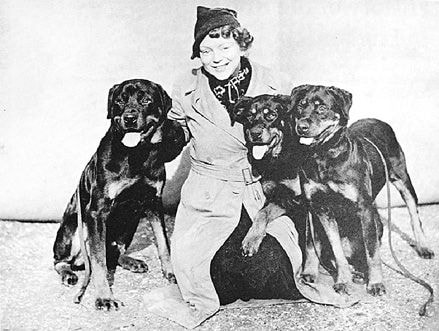
The first Rottweiler was imported into the UK in 1936 by Mrs Phil (Thelma) Gray of the Rozavel kennels. This bitch was called Rozavel Diana von der Amalienburg SchH I born in May 1934 but she was not successfully bred from. Mrs Gray continued to import more dogs, but due to the outbreak of World War II in 1939 they were sent over to Ireland for safe-keeping. After the war, attempts were made to find them and return them to England but they had vanished without trace.
The first post-war Rottweilers were imported by Captain F. Roy Smith of the Royal Veterinary Corps in March 1953. They were Ajax von Fuhrenkamp and Berny von Weyher [below]. However, this breeding pair was unsuccessful in producing a litter.
The first post-war Rottweilers were imported by Captain F. Roy Smith of the Royal Veterinary Corps in March 1953. They were Ajax von Fuhrenkamp and Berny von Weyher [below]. However, this breeding pair was unsuccessful in producing a litter.
|
After a time, many more Rottweilers were imported from Europe and a breeding pattern was gradually established. The Rottweiler was first registered by the Kennel Club as a breed in its own right in 1965 although in 1936 the breed was listed by the Kennel Club as “Any Other Breed or Variety of British, Colonial or Foreign Dog Not Classified” !!
Yearly registrations have risen steadily from about 48 in 1966 to 6,575 in 2006. The Rottweiler had been little known to the general public until 1989, when the yearly registration hit a frighteningly high figure of 10,341. The breed hit the headlines in the newspapers, suffering the most appalling persecution from the public and media alike. Thankfully today, the registrations are much much lower and the breed is once more acceptable to the public. |
Training
The Rottweiler started out as a working dog hundreds of years ago and this is still his inheritance today. Training should start at an early age and there are many people willing to help you.
Good Citizen Dog Scheme
Whilst this is not an exact activity in itself, it is worth mentioning here as a good place to start your basic obedience training. Weekly classes are run by experienced, qualified trainers and are held up and down the country, for a fee. There are three levels of achievement: Bronze, Silver & Gold.
The Kennel Club Good Citizen Dog Scheme is the largest dog training scheme in the UK. Its aim is to promote responsible dog ownership and in turn, enhance our relationship with our pets and to make the community aware of the benefits associated with dog ownership.
Dog training classes are also a great way to socialise your dog and meet other dog owners. So whether you have a beginner puppy or an older dog in need of a refresher class, find a dog training class to suit you with the Kennel Club Good Citizen Dog Scheme.
More information can be found from the Kennel Club at: http://www.thekennelclub.org.uk/dogtraining
There are many activities at which the Rottweiler excels, and these all use a basic training method of praise and reward. These activities include:
Competitive Obedience
Competitive Obedience requires accuracy and precision. Trained in the right manner with lots of praise and reward, the Rottweiler is very suited to this activity. There are several elements: Heelwork, Recall, Retrieve, Sendaway, Stays, Scent, Distance Control. Classes start with Pre-Beginners through to Class ‘C’ which is the top Championship level.
More information: http://www.thekennelclub.org.uk/obedience
Agility
This fun sport has grown in popularity. It is a basic course over a series of obstacles which include: Jumps, Weaving, Poles, A-Frame, Dog Walk, Seesaw, Tunnels, Tyre. The aim is to complete the course in the fastest time; your dog should be kept fit and slim and you need to be especially fit yourself too!
More information: http://www.thekennelclub.org.uk/agility
Flyball
This is a team sport in which four dogs run in relay and jump hurdles, catch the flying ball by stepping on a pedal which releases the ball; then going back to the handler over the same jumps. The fastest team wins. The sport is noisy, fast and furious and the dogs love it!
More information: http://www.thekennelclub.org.uk/flyball
Working Trials / IPO
These sports are for the serious competitor. They consist of four basic components: Control, Agility, Tracking, Protection. They are extremely challenging sports which require total control of your dog as each stage becomes more intense. To get to the top stakes the dog has to compete and qualify in each stage, starting at the bottom. Working Trials are unique to the UK but IPO is practised the world over and is growing in popularity. Training and competition takes place in all weathers! There are five achievement levels in Working Trials known as “Stakes” – from the lowest to highest: Companion Dog, Utility Dog, Working Dog, Tracking Dog, Patrol Dog.
More information: http://www.thekennelclub.org.uk/workingtrials
Good Citizen Dog Scheme
Whilst this is not an exact activity in itself, it is worth mentioning here as a good place to start your basic obedience training. Weekly classes are run by experienced, qualified trainers and are held up and down the country, for a fee. There are three levels of achievement: Bronze, Silver & Gold.
The Kennel Club Good Citizen Dog Scheme is the largest dog training scheme in the UK. Its aim is to promote responsible dog ownership and in turn, enhance our relationship with our pets and to make the community aware of the benefits associated with dog ownership.
Dog training classes are also a great way to socialise your dog and meet other dog owners. So whether you have a beginner puppy or an older dog in need of a refresher class, find a dog training class to suit you with the Kennel Club Good Citizen Dog Scheme.
More information can be found from the Kennel Club at: http://www.thekennelclub.org.uk/dogtraining
There are many activities at which the Rottweiler excels, and these all use a basic training method of praise and reward. These activities include:
- Competitive Obedience
- Agility
- Flyball
- Working Trials / IPO
Competitive Obedience
Competitive Obedience requires accuracy and precision. Trained in the right manner with lots of praise and reward, the Rottweiler is very suited to this activity. There are several elements: Heelwork, Recall, Retrieve, Sendaway, Stays, Scent, Distance Control. Classes start with Pre-Beginners through to Class ‘C’ which is the top Championship level.
More information: http://www.thekennelclub.org.uk/obedience
Agility
This fun sport has grown in popularity. It is a basic course over a series of obstacles which include: Jumps, Weaving, Poles, A-Frame, Dog Walk, Seesaw, Tunnels, Tyre. The aim is to complete the course in the fastest time; your dog should be kept fit and slim and you need to be especially fit yourself too!
More information: http://www.thekennelclub.org.uk/agility
Flyball
This is a team sport in which four dogs run in relay and jump hurdles, catch the flying ball by stepping on a pedal which releases the ball; then going back to the handler over the same jumps. The fastest team wins. The sport is noisy, fast and furious and the dogs love it!
More information: http://www.thekennelclub.org.uk/flyball
Working Trials / IPO
These sports are for the serious competitor. They consist of four basic components: Control, Agility, Tracking, Protection. They are extremely challenging sports which require total control of your dog as each stage becomes more intense. To get to the top stakes the dog has to compete and qualify in each stage, starting at the bottom. Working Trials are unique to the UK but IPO is practised the world over and is growing in popularity. Training and competition takes place in all weathers! There are five achievement levels in Working Trials known as “Stakes” – from the lowest to highest: Companion Dog, Utility Dog, Working Dog, Tracking Dog, Patrol Dog.
More information: http://www.thekennelclub.org.uk/workingtrials
|
In a litter born 24 August 1957, three females were registered according to the Kennel Gazette December 1957 (Belinda of Mallion, also Brangane and Brunhilde) also four males (Balthasar, Boris, Brutus and Bruin). Bruin of Mallion was owned by Mrs. Maud Wait (Lenlee) and apart from being unbeaten in the show ring at the time, became the breed’s first Working Trials Champion gaining CDex, UDex and TDex titles in 1962. No Challenge Certificates were on offer then, but had there been, it is alleged, he would certainly have become a Show Champion.
Bruin of Mallion CD, UDex, TDex - The first Rottweiler to become a Working Trials Champion |
